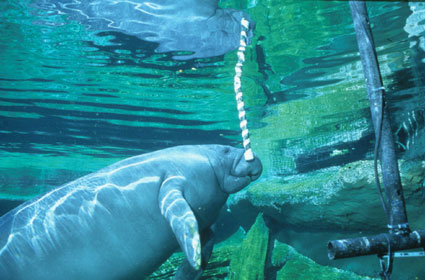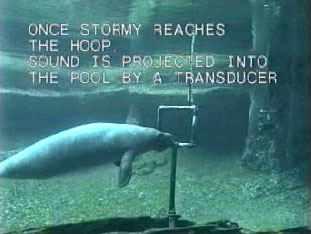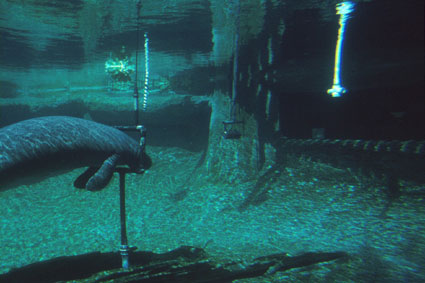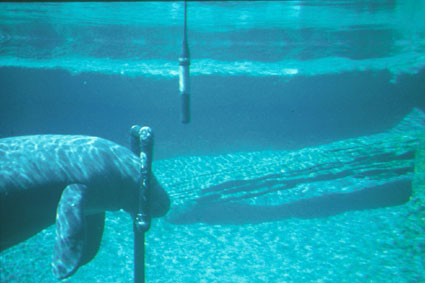Edmund R. Gerstein - Gerstein2@aol.com
Leviathan Legacy Inc. / Florida Atlantic University
1318 SW 14th Street, Boca Raton, Florida 33486
Laura A. Gerstein, Joseph E. Blue (Leviathan Legacy Inc.),
and Steve E. Forsythe (Navy Undersea Warfare Center)
Popular version of paper 4aAB5
Presented Thursday morning, December 6, 2001
142nd ASA Meeting, Fort Lauderdale, FL

After only a few hours of sleep following another 7 PM to 3 AM research session, the elephants' thunderous trumpeting pierces the dawn and once again awakens Edmund and Laura Gerstein as they rest in their tiny research trailer nestled at the back of the Lowry Park Zoo.
"Some mornings we just laid there in bed unable to move, wondering what would get us first, the long late hours, the elephants on their early morning walks past our trailer before the zoo opened, or perhaps a zookeeper who missed his coffee that morning before navigating his two-ton tractor along the narrow service road where our lowly trailer precariously sat." Dr. Gerstein jokes that aside from their research findings on manatee hearing and behavior, perhaps the most remarkable result is that after more than 5 years of living in a 19-foot research trailer, without a bathroom and in the back of a zoo, he and Laura, his wife and partner of 18 years, are still together.

It's a good thing for Florida's manatees that the Gersteins have persevered. Together with Dr. Joseph Blue and Steve Forsythe, they have revealed an underlying cause explaining why manatees are hit by boats and barges. Their research contradicts long-held beliefs, and seriously challenges the rationale of conventional manatee protection strategies.
Prior to the Gersteins's behavioral hearing research and acoustic measurements, many wildlife biologists and managers assumed manatees could readily hear boats, but were just too slow or too stupid to avoid water craft. Gerstein and his coworkers doubted these assumptions and conducted a rigorous and comprehensive series of investigations to better understand why manatees are frequently hit by boats. They have since documented the underwater hearing abilities of West Indian manatees, as well as the acoustic characteristics of their unique shallow water habitats and the sounds of recreational and commercial vessels which injure the animals. The results of their research demonstrate that manatees cannot effectively hear and locate the dominant low-frequency sounds produced by many approaching boats until they are too close to avoid injury. These constraints, along with the acoustic masking of sounds by naturally occurring ambient conditions, make it very difficult for manatees to detect vessels.
HOW DID THEY DO THAT ?
The best way to find out what an animal can truly hear is to simply ask it. The Gersteins trained manatees to perform a series of behavioral hearing tests. The accompanying video shows a manatee named Stormy performing some test trials. Stormy was trained to position himself inside a listening station hoop where an underwater microphone (hydrophone) recorded the signals sent to him. The tests were repeated for many different types of sounds, including boat noise. They were conducted under quiet conditions as well as noise conditions typical of the ambient levels recorded in many manatee habitats. The latter tests measured how manatee hearing is affected by natural noise.

Click on the above picture to see the video
BOAT NOISE AND MASKING
Manatees hear best at frequencies between 16,000 and 18,000 Hz. Unfortunately the dominant sounds produced by most boats and ships are below 1,000 Hz, and fall outside or only overlap the lower fringe of the manatees' hearing range. Like most animals, manatees live in noisy environments, and in their natural habitat boat sounds must be much higher than background noise before the manatee can detect them. The low-frequency sounds emitted by boats and ships can be indistinguishable from ambient noise until the vessels are literally on top of the manatees.

Conventional management strategy for protecting manatees is to slow down boats with slow speed and idling zones. In fact, the strategy exacerbates the problem in cloudy waters where manatees and boaters cannot actively avoid each other visually. Slower boats are quieter and produce lower frequency noise than faster moving boats. Ironically the sounds of faster moving boats are louder and contain higher frequencies that manatees can hear and locate under typical conditions
This phenomenon is demonstrated in the soundtracks of videos that record a boat moving slowly, and then traveling fast under the same ambient conditions. Snapping shrimp create the crackling background sounds. A series of hydrophones is suspended vertically from the yellow buoy on the surface. The hydrophones record the sound a manatee would hear at various depths under yellow buoy as a boat approaches. A boat moving at 3 mph is just detectable to the manatee approximately 2 to 3 seconds, which equates to 12 - 18 feet, away from the propellers (keep in mind that the hull of the boat extends 24 feet ahead of the propellers). In comparison the same boat traveling at 24 mph is detectable in at least 16 seconds, or approximately 650 feet, before the moment of impact.
Results from myriad tests reveal that, for manatees, sounds propagated in front of small boats traveling approximately 3-4 mph are indistinguishable from ambient noise until the animals are 6 to 24 feet from the propellers. Conversely, the sounds of boats traveling 24 mph can be detected at distances greater than 600 feet from the propellers.
BARGES AND SHADOWS

Click on the above picture to see the video
The results of the underwater sound measurements reveal that a wide acoustic
shadow is produced ahead and to the sides of barges. When a clear line of propagation
from the tug propellers to the hydrophones is reached the sound level increases
dramatically.
WHAT CAN BE DONE?

While manatees are well adapted to shallow water, they are at a distinct sensory disadvantage in dealing with boats. Luckily their acute hearing at higher frequencies provides a window through which we can provide them the sensory awareness required to detect approaching boats. By exploiting their best range of hearing, we can design an acoustic warning device to produce very low intensity highly directional signals which manatees will hear and locate only when they are in the direct path of a vessel.
Manatees as well as whales are frequently injured and killed from collisions
with ships and barges. Near the ocean's surface, as well as shallow water, low-frequency sounds from many vessels are omnidirectional and indistinguishable
from the ambient noise. While whales may have relatively good low-frequency
hearing they can not react to sounds which never reach them at the surface.
For manatees detecting vessel noise is more challenging as they have poor low-frequency
hearing and localization abilities. Perhaps the most serious of their shared
challenges are those vessels which cast very large acoustic shadows directly
in front of them. These vessels are essentially acoustically invisible as they
directly approach whales or manatees. To alert manatees and whales of approaching
ships in enough time to avoid injury, a low-intensity, highly directional underwater
acoustic emitter is being developed for military, commercial, and recreational
vessels.